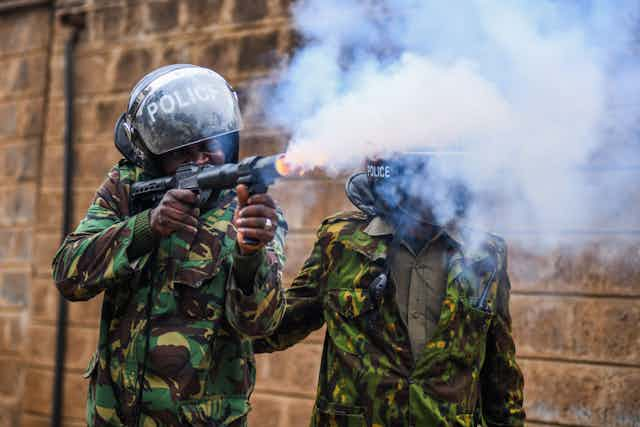Across the African continent – from Nigeria and Ghana to South Africa – widespread protests have taken place to demand police reform in the wake of police misconduct and brutality. A continent-wide survey done in 2022 shows very low trust in the police and a prevailing perception of the police as the most corrupt among key institutions.
Low public trust in police poses a serious problem for the most central state institution tasked with upholding law and order. Trust influences both police effectiveness and the perception of safety among the public.
We are scholars with a longstanding research engagement with Kenya who study the role of the police from the perspective of conflict research and political science. In a recent study, we set out to analyse citizens’ trust in the police in Kenya.
We analysed data from four national surveys conducted in the country between 2011 and 2019. In each survey, respondents were asked a number of questions, including how much they trusted the police. These surveys found that Kenyans had limited trust in the police.
Trust, as we study it, is an individually held belief that a certain actor can be relied on. It is closely related to perceptions about fairness and legitimacy. We argue that individuals who have witnessed or experienced unfair treatment by the police are more likely to mistrust them.
Our study found that urban and rural residents in Kenya perceived the police differently. Those in cities and urban centres had lower trust in the police than the rural population. The findings matter because Kenya is rapidly urbanising, and the policing challenges we describe will grow with the expansion of urban centres.
Additionally, reform processes intended to improve legitimacy and effectiveness of Kenyan policing will be more likely to succeed if there is adequate understanding of the contexts in which the police operate, and how environments shape citizens’ perceptions of the police.
Understanding the differences in trust
Over several years, we have conducted interviews with local residents, the police, experts and civil society actors in Kenya. Based on our research, we argue that three major dynamics help explain the urban-rural divide in police trust.
Firstly, the police face different security challenges in urban and rural settings. Urban environments are generally more challenging than rural contexts because:
police-citizen interactions are more frequent and visible to the public in cities
many different groups and interests are present in cities.
Secondly, police have been involved in extrajudicial killings in urban settings. These have primarily affected poor, young men in low-income and densely populated settlements. An estimated 50% of Kenya’s urban population will be residing in slums, as defined by UN Habitat’s World Cities Report, by 2030. It is in these types of settlements that police have become notorious for arbitrary arrests and use of excessive force.
This behaviour has negative spillover effects on the urban population and makes citizens in urban areas more likely to form negative views of the police.
Read more: Many Kenyans have embraced vigilante cops – an ineffective police force is to blame
Third, the dynamics in rural settings are different from those in urban areas. In many rural locations, police are spread thin. They cover large jurisdictions and geographical distances, influencing whether and how citizens can be served. Although around 70% of Kenya’s population lives in rural areas, such areas are usually served by few and often under-resourced police officers. A task force reviewing ongoing police reforms recently concluded that police vehicles in rural areas don’t always have enough fuel to cover the area under jurisdiction.
Due to limited interactions with the police, Kenyans in rural areas are less likely to see the police as a relevant actor, for good and for bad, and are more likely to turn to other security providers. These include community-based militias and vigilante groups.
Implications for police reforms
In Kenya, law enforcement remains influenced by colonial legacies and extended periods of authoritarian rule. In colonial times, the police were used to repress and control Kenyans.
Addressing these legacies is necessary for democratic consolidation.
Kenya has initiated police reform with the purpose of building a more legitimate and effective police force. A major reform process began in 2009, codified into the 2010 constitution and new police legislation in 2011. These processes established national policies for community policing and an independent agency to improve civilian oversight.
However, progress has been limited. Corruption within the Kenyan police remains widespread and normalised. Impunity remains high. Despite an emphasis on community policing, the establishment of such structures has been uneven, and public awareness remains low.
Read more: Kenya has tried to reform its police force, but it's left gaps for abuse
The need to improve police-community relations is underlined by frequent transgressions of human rights and police brutality, including over 100 extrajudicial killings documented in the last year.
Therefore, improving security provisions and reducing misconduct in informal settlements in urban areas should be a key priority.
Better oversight to address impunity would help address issues of trust, but the police also need sufficient resources to carry out policing tasks. Investing more in community policing structures – intended to serve as a link between communities and the police – could also help improve relationships and build trust.
Much of Kenya’s police reform is premised on addressing the most serious problems facing urban areas. While it’s important to address issues of insecurity here, reform processes must not lose sight of priorities in rural areas, where the majority of the population still reside.

